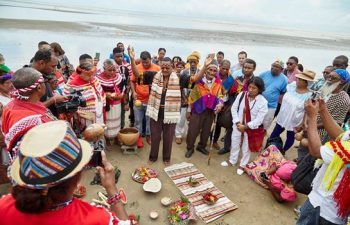By Catherine Serrant
On the 14th October every year Trinidad and Tobago commemorates the for the First Peoples Community. The Santa Rosa First Peoples Community is widely known but they are not the only First People community in Trinidad. There are other groups such as the Warao nation. The Santa Rosa First Peoples choose to celebrate their heritage as descendants of Trinidad’s indigenous Nepoyo and or Carinepogoto community through a variety of spiritual ceremonies and a week of cultural events and displays involving the public. We have the real deal- this group has been recognized by both the Government and by as the official representatives of our indigenous people. This makes them the official preservation and cultural ambassadors for their community, which is essential if we wish to ensure that their culture is passed down to newer generation and the wider public as well.

Photo by Bertrand De Peaza[1]
In the previous years, special guests made up of other indigenous Caribbean communities from Guatemala, Venezuela, Suriname and Guyana came to Trinidad to be part of the activities.
The celebrations were usually initiated with a ceremony at the First People’s Headquarters in Arima and typically involved+ a follow up ceremony at Santa Rosa Roman Catholic Church. This year the smoke ceremony was held at the Red House in Port of Spain. Water rituals are performed the following day, in remembrance of the ancestors. On the 14th, there is usually a smoke ceremony at the Hyarima statue and then a procession through the streets. Smoke ceremonies play an integral role in this community, as they display the indigenous religious rituals in a public setting. These offerings and invocations do several things namely: they praise the Earth and protect Earth’s spiritual and physical integrity; it is a way for ancestors to be remembered and is a request for blessing on the First Peoples and their families by the “Great Spirit”[2].

Reflection time! Why is this important to Trinidad and Tobago as a nation? One word- continuity. The First Peoples existed in Trinidad for thousands of years, prior to the arrival of colonizers. Today’s celebrations are more than a cultural revival started in the 1990s. This is a real opportunity for all of us to connect with a part of our heritage that Eurocentric history books and school curriculums relegated to the shadows of knowledge. Their open displays (and invitations) are a chance for the rest of T&T to observe, actively participate in and to understand aspects of their heritage which may be new.
Further, we’ll have you know that Hyarima is considered T&Ts first national hero[3]. His repelling and harassment of Spanish colonizers was a critical factor in the survival of the Nepoyo community and their traditions. With continuity in mind, our Santa Rosa First People’s Community represents the importance of deep rooted belief and faith; that retaining our traditions and passing them down to future generations is an essential part of succession planning (which takes a great deal of foresight to do). We can all learn from our First Peoples how to cherish our aboriginal spirituality, and to maintain and adapt them to the needs of today.
On Monday 12th October 2020, the Santa Rosa First Peoples Community were part of a virtual symposium held by University of the West Indies, titled “Our First Peoples- Leading Us Toward Environmentally Sound and Sustainable Communities”.[4] An important aspect of their spirituality is the safeguarding and protection of Earth, which is most readily translated into reality via wholesome and sustainable practices in agriculture, farming, food production and textiles. It has been proven that biodiversity flourishes wherever indigenous communities live. All of these indicate how amazing it would be if Trinbago were to adopt an attitude that is more like the “First Peoples” towards our environment! We encourage you to start at the most basic level then- to have a curious frame of mind towards the values, traditions and cultural practices of the Santa Rosa First Peoples.
The cherry on top of this cake: all of the rich cultural heritage is linked to our built heritage! More than 5000 years old in both instances, the Caurita petroglyphs and Banwari Trace Archaeology site are two significant aspects of the indigenous world that still exist today and happen to be the only two protected Indigenous listed national heritage sites. Extensive efforts have gone into the protection of these, and they hold a special spiritual place within the First Peoples communities. To learn more about the petroglyphs and pictographs carved by our ancestors, this video is an awesome virtual start. Next, you should follow this link and for the contents of Banwari Trace, click here. For the archaeology lovers among us, we won’t leave you out! Can you ever get tired of tracing our development in this specialized field? Nope, so here’s to happy reading: check out Archaeology in Trinidad and Tobago through the years.
Sources
Maximillian Forte. The Santa Rosa Carib Community. 2006
http://web.archive.org/web/20080608170013/http://www.kacike.org/srcc/smokeceremony.html
The First Peoples Presence In Trinidad and Tobago. NALIS 2020
https://www.nalis.gov.tt/Resources/Exhibitions-and-Photo-Galleries/ID/26/FIRST-PEOPLES#prettyPhoto
“Our First Peoples- Leading Us Toward Environmentally Sound and Sustainable Communities” Symposium. UWI St. Augustine. 2020
https://www.facebook.com/UWISTA/videos/905924563271777
Hyarima Plaque. NALIS First People’s Gallery
https://www.nalis.gov.tt/Resources/Exhibitions-and-Photo-Galleries/ID/26/FIRST-PEOPLES#prettyPhoto
Bertrand De Peaza, Facebook Photo. Taken from Santa Rosa First People’s Community Facebook page.
https://www.facebook.com/santarosafirstpeoplescommunity/photos/a.454196394657136/1696508887092541
[1] https://www.facebook.com/santarosafirstpeoplescommunity/photos/a.454196394657136/1696508887092541
[2] Forte.
[3] NALIS
[4] UWISTA
